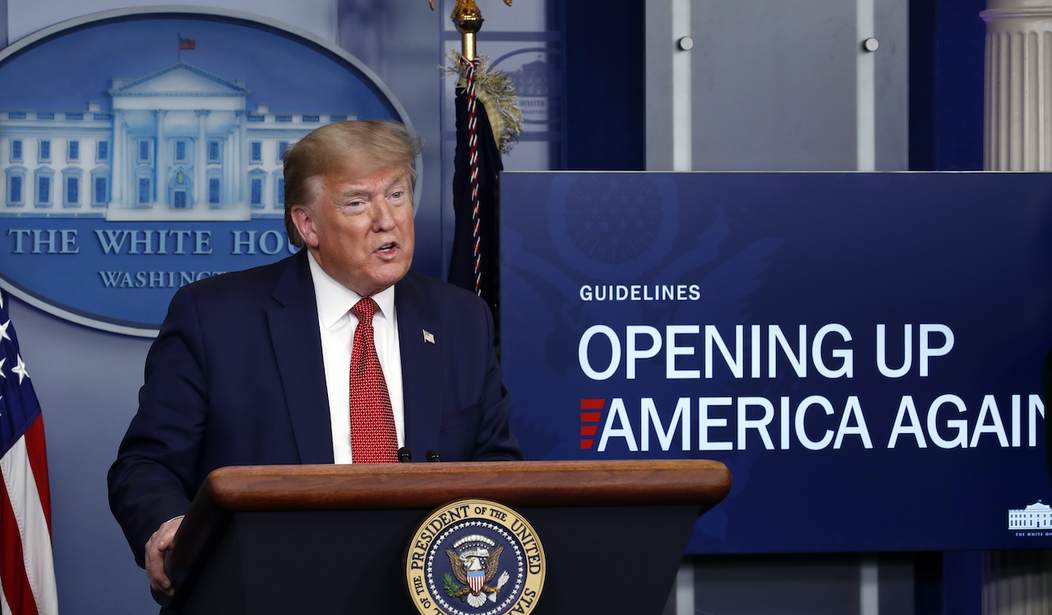The Guidelines for Opening Up America Again released by President Trump on April 16 reveal a balance of sound medical and economic planning. But they make solid sense from a psychological perspective as well.
In fighting the COVID-19 pandemic, President Trump has warned that the cure must not be worse than the disease and that any long-term strategy must protect both the physical and also the economic and social health of the nation. State-level lockdowns have played a major part in flattening the curve of disease growth. But with businesses closing across the nation, unemployment claims coming in by the millions each week, and projections that continued lockdowns could result in Depression-era unemployment levels, the wisdom of the President’s position is becoming indisputable.
A recent poll by McLaughlin and Associates confirms the President’s concern that we must address the nation’s economic fears even as we combat the virus. Two-thirds of respondents in March said that the economy is getting worse, a huge jump from the February numbers. And those who said the economy is in a recession jumped from just under 20 percent in February to 44 percent in March. At a more personal level, 35 percent overall and 50 percent of those under age 55 said they could only afford to be out of work for one month or less. Those percentages dropped when respondents were asked about longer periods out of work.
Outside the relative safety of lockdown, however, lurks the coronavirus. Any plan for reopening America must help to manage the fear that appropriately comes with the reopening. Otherwise, fear will keep Americans emotionally locked down and hesitant to resume normal activities even as the physical lockdowns are eased. In a sense, we must flatten the fear curve just as we have flattened the curve of disease growth.
Recommended
Fear of economic ruin is clearly rising, yet the fear of the virus remains understandably strong. Psychologically, Americans are in a classic approach-avoidance conflict. People want and need to get back to some semblance of normalcy, to get back to work and to ease the growing financial fears. But doing so could raise the risk of contracting the virus, and the resulting fear could keep people from doing what they need to do in order to get the country back on its feet.
And that is why the Guidelines for Opening Up America Again make solid sense from a psychological perspective as well as from the medical and economic perspectives.
Psychologists understand fear as one of the primary survival emotions. The fear system that exists in all mammalian brains provides the motivation to avoid and escape harmful situations. Because of its importance to survival, fear is not something to be eliminated but managed.
Fear occurs along a continuum from low to high, and it affects behavior differently at different intensities. Too little fear in a dangerous situation leads to complacency and foolish risk. At very high levels, however, fear can lead to avoidance of reasonable activities and interfere with the ability to meet other needs such as social activity and providing for ourselves and our families. But, between the extremes of complacency and panic, managed fear can focus our attention and provide the energy we need to take appropriate precautions when confronting risk.
The Guidelines do not downplay the risk of the virus, but neither do they yield to over-reaction and panic. Instead, they keep fear at manageable levels by opening America in stages, relying on objective data for safe movement from one stage to the next, and allowing for quick adjustment in the case of the resurgence of the virus.
Those are the kinds of tools that psychologists have used for decades to help people to handle feared situations. A gradual approach to the feared situation keeps fear at a manageable level. Objective information helps people to see the feared situation in a more rational and less emotional light.
Fear is exacerbated when there is a sense of loss of control and helplessness, so psychologists provide practical tools to help people perform in feared situations. And each stage of the Guidelines is packed with practical tools and protections, ranging from screening and testing to methods for keeping employees safer as they return to work.
Once a stage is completed safely according to objective gating criteria, there is a gradual increase in normal activity at the next stage. Even within each stage, however, provisions are made to address the safety of populations at higher risk.
And rather than forcing all fifty states to reopen at the same time, the plan allows each state to assess its situation and reopen as local conditions warrant.
Nothing will appease partisan critics who are more focused on undermining the President for their own political ends than on guiding the nation through this crisis. But President Trump and his team have produced Guidelines that steer the nation between the dangers posed by both the virus and by a stalled economy.
The path forward is grounded in prudence, but not panic.
Dr. Tim Daughtry is a conservative speaker and co-author of Waking the Sleeping Giant: How Mainstream Americans Can Beat Liberals at Their Own Game. Follow him on Twitter @TCDwriter.

























Join the conversation as a VIP Member